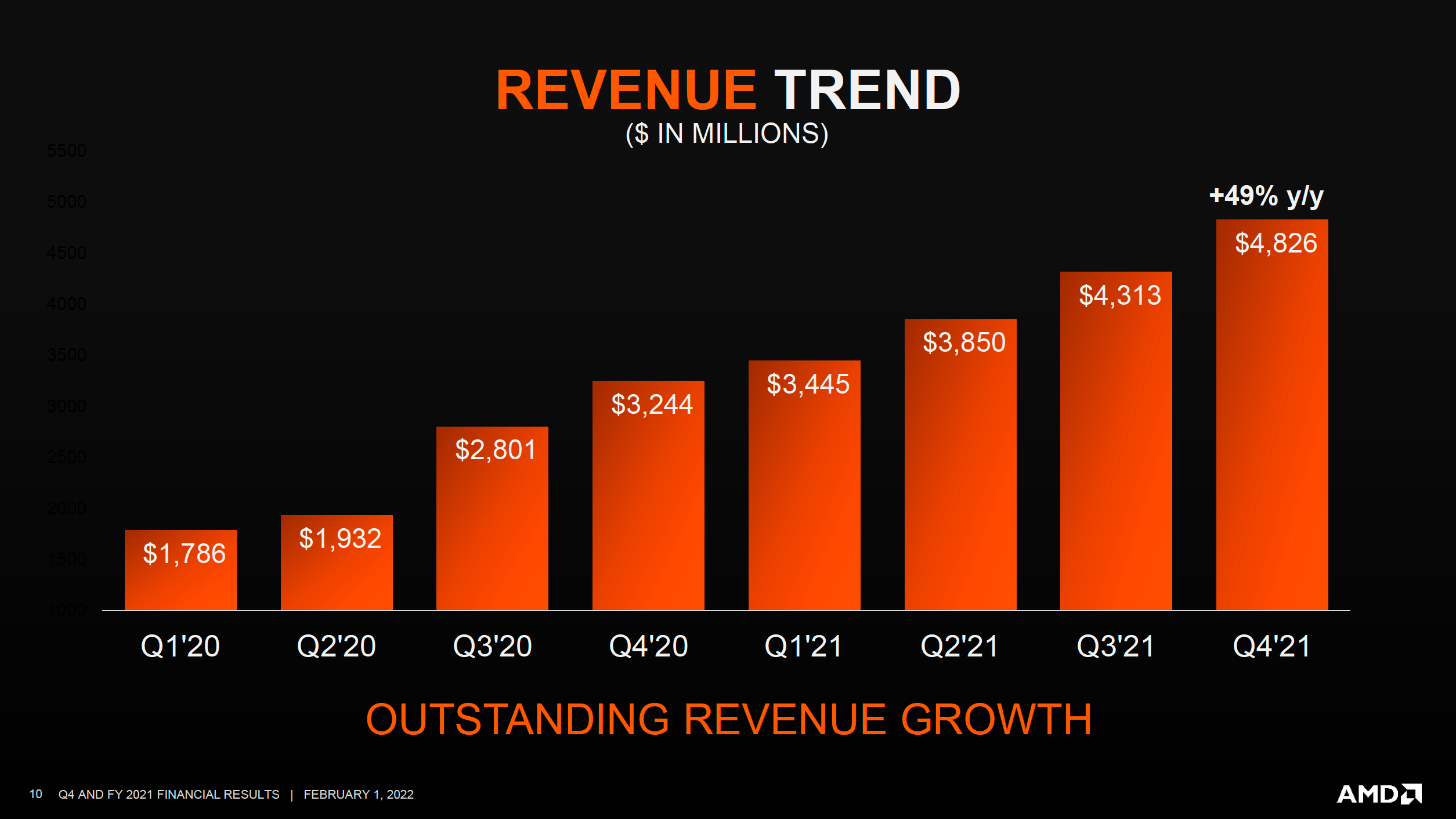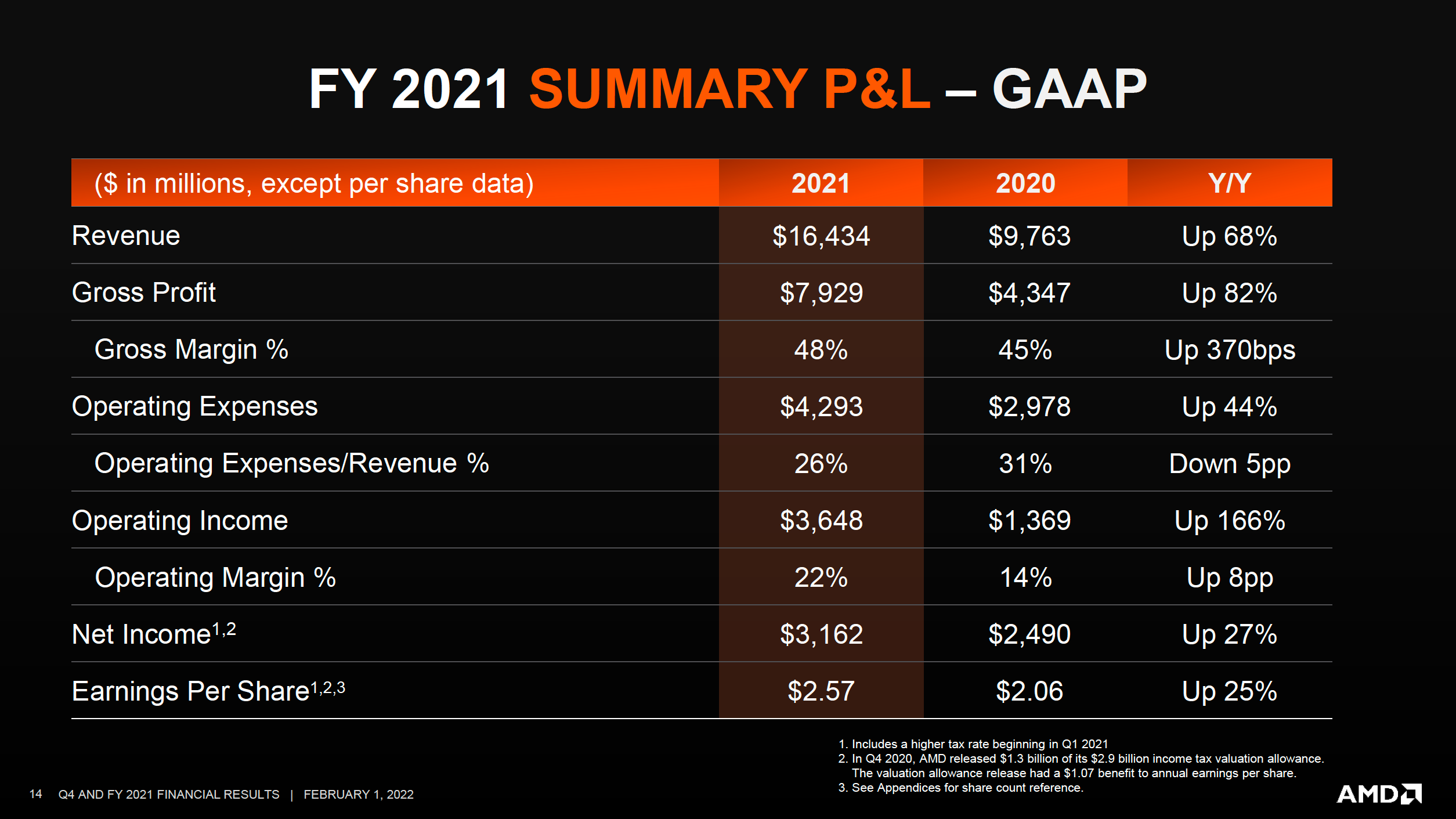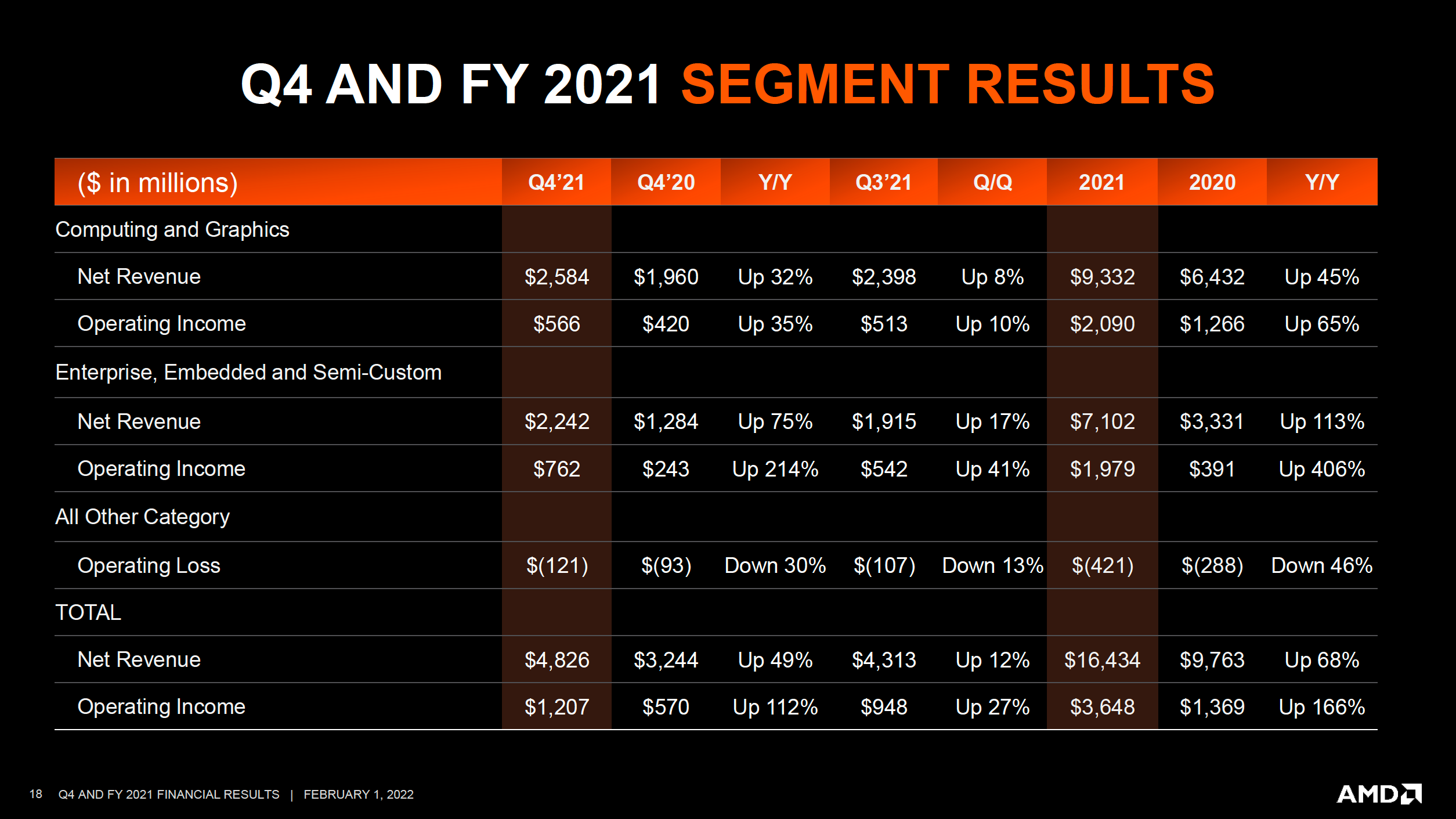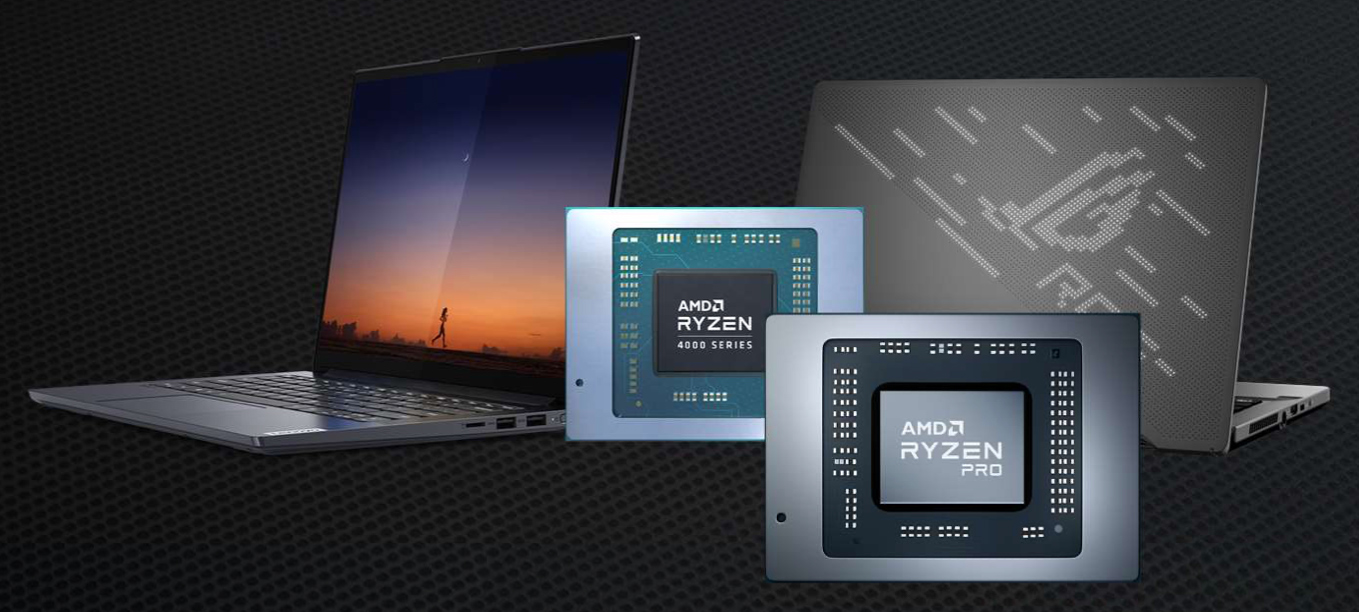AMD's 2022 Sales Hit $21.5 Billion As It Posts Best Quarter in History
AMD increases its annual revenue by 68% in 2021.
The strong demand for AMD's processors, and the competitive advantages the company has over rivals, bolstered the company's sales by around 50% year-over-year for six consecutive quarters now. Strengthening competition from Intel yet has to have its effect on AMD, so the company's winning spree continued with record quarterly earnings in Q4 of 2021. As for the year, the company posted its highest annual revenue in history and healthy margins. Perhaps more importantly, the company vowed to earn $21.5 billion in 2022.
Record Quarter & Record Year
AMD received $4.826 billion in revenue for the fourth quarter of its fiscal 2021 (which ended December 25, 2021), a 49% year-over-year increase. The company's GAAP net income totaled $974 million, down from $1.781 billion in Q4 2020, mainly because the fourth quarter of 2020 included an income tax benefit of $1.3 billion associated with a valuation allowance release. Meanwhile, the company's gross margin in Q4 2021 increased to 50%, up 5% from the same period a year before.
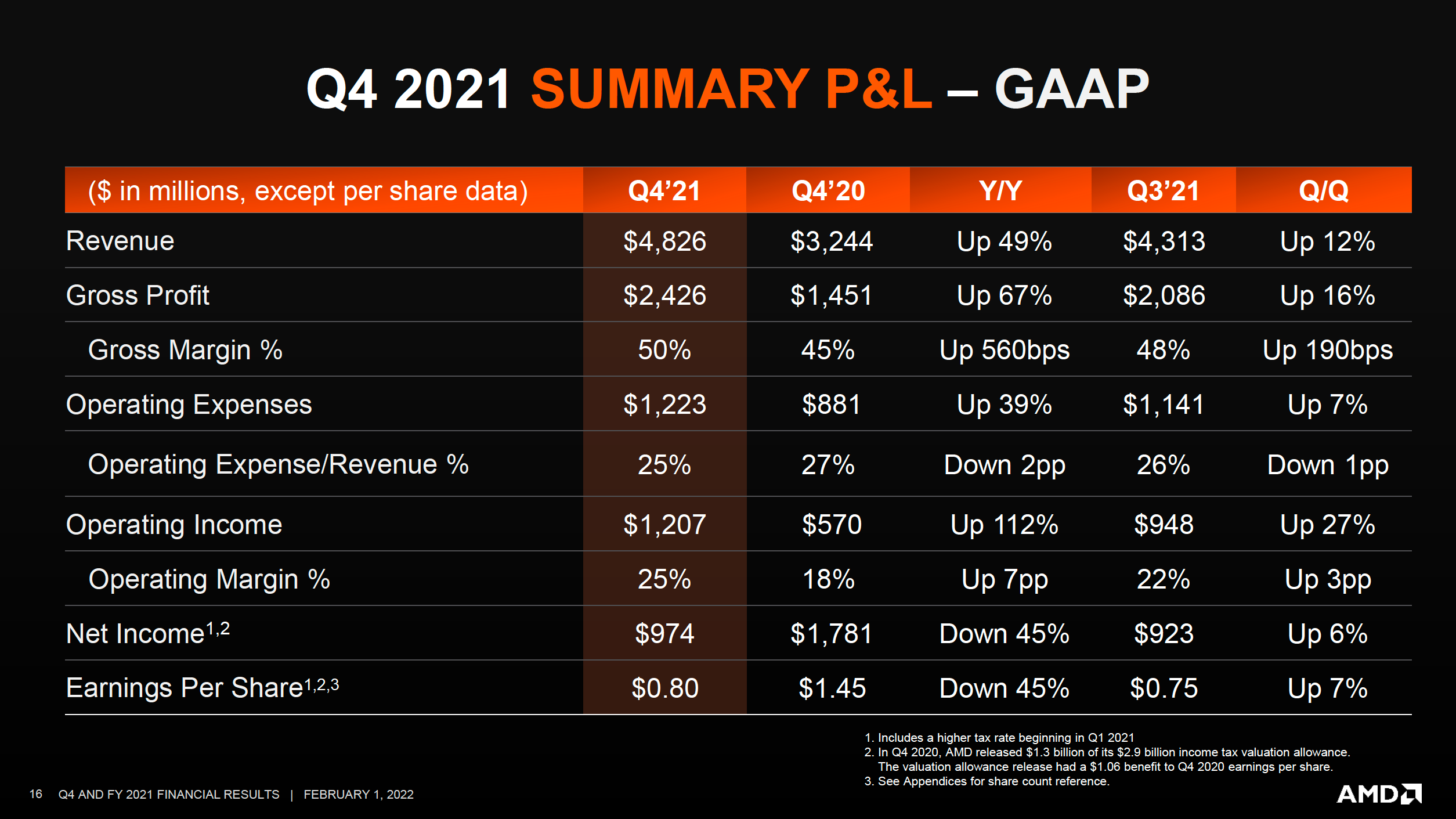
As for the full fiscal year 2021, AMD's revenue reached $16.434 billion, up a whopping 68% year-over-year. The company's net income for the year was $3.162 billion, a 27% growth per annum, whereas its gross margin for the whole year increased to 48% (from 45% in 2021). AMD's earnings per share boosted to $2.57, up from $2.06 a year before.
"2021 was an outstanding year for AMD with record annual revenue and profitability," said AMD President and CEO Dr. Lisa Su. "Each of our businesses performed extremely well, with data center revenue doubling year-over-year driven by growing adoption of AMD EPYC processors across cloud and enterprise customers. We expect another year of significant growth in 2022 as we ramp our current portfolio and launch our next generation of PC, gaming and data center products."
Compute & Graphics Business
AMD's CPUs and GPUs for PCs have been its bread and butter for years, and that continued to be the case in Q4 2021. AMD's Computing and Graphics business unit earned $2.6 billion in revenue, up 32% year-over-year, and an 8% increase quarter-over-quarter due to higher sales of its Ryzen and Radeon products. In addition, the division posted a $566 million operating income for the fourth quarter, up from $420 million in the same quarter a year ago, primarily because of record sales of notebook processors and, therefore, higher average selling prices (ASPs).
Speaking of ASPs, since AMD prioritized production of premium APUs and CPUs for commercial, gaming, and workstation PCs, its client CPU average prices have increased sequentially and yearly.
"We increased the number of premium gaming and commercial design wings from Acer, Dell HP, Lenovo, and other major PC providers to more than 200, including more than 20 AMD Advantage notebooks that combined Ryzen CPUs and Radeon GPU's […] to deliver the ultimate gaming experience," said Su.
Get Tom's Hardware's best news and in-depth reviews, straight to your inbox.
Thanks to the improved supply of higher-end Radeon RX 6000-series client GPUs in Q4, sales of standalone graphics processors doubled year-over-year, and the company's GPU ASPs increased. Meanwhile, since in the fourth quarter, the company began shipping its lowest-end RDNA 2-based parts in Q4, its average selling prices per GPU dropped QoQ.
"In graphics, revenue more than doubled year-over-year for the third straight quarter as Radeon RX 6000-series GPU unit shipments and revenue both grew by double-digit percentages sequentially led by strong demand across our RDNA 2 desktop family," said the head of AMD.
AMD's datacenter GPU revenue also doubled year-over-year in the fourth quarter driven by the adoption of the company's Instinct MI200-series compute accelerators by high-performance computing (HPC) customers.
"Our datacenter graphics revenue more than doubled year over year driven largely by HPC wins for our latest Instinct MI200-series accelerators," said Su. "We are seeing growing customer engagements for our datacenter driven by the leadership AI and HPC performance of our new MI200-series accelerators highlighted by multiple supercomputing wins and an expanded set of platforms on track to launch from Atos, Dell, HP, Lenovo, Supermicro, and others later this quarter."
AMD's C&G business unit earned $9.332 billion in net revenue and posted $2.090 billion in net income for the full year.
The main challenge that AMD faced in recent quarters is across-the-board supply constraints, which required the company to prioritize certain products over others. While AMD admits that this approach has slowed down its market share growth, it also implies that it increased unit shipments in Q4 2021.
Enterprise, Embedded & Semi-Custom Business
Traditionally, AMD's Enterprise, Embedded, and Semi-Custom (EESC) business unit have lagged behind its C&G division in terms of sales, but the success of the company's EPYC processors for servers as well as semi-custom system-on-chips for Microsoft's and Sony's game consoles is increasing its sales at a pace that exceeds that of C&G BU.
AMD EESC's revenue skyrocketed to $2.2 billion in Q4 FY2021, up 75% year-over-year and 17% sequentially. In addition, the operating income reached a record $762 million, up a whopping 284% compared to the same period a year ago and a 36% increase sequentially. As for the whole year, the group earned $7.102 billion in revenue, up 2.13 times compared to 2020, and $1.9179 in operating income, which is a 400% increase compared to the previous year.
Today, there are over 100 third-gen AMD EPYC-based platforms available from various OEMs, which certainly helps AMD boost dollar and unit sales. In addition to enterprises buying AMD EPYC-based servers, the CPUs continue to gain traction with cloud datacenter operators.
"[Datacenter platform] revenue more than doubled year-over-year and increased by a double-digit percentage sequentially driven by demand across both cloud and enterprise customers," said Lisa Su. "In cloud, revenue more than doubled [YoY] as the largest providers expanded internal deployments and more than 130 new AMD powered instances launched from Amazon Web Services, Alibaba, Google, IBM, Microsoft Azure, and others. Microsoft Azure previewed a new HPC instance powered by our 3rd Generation EPYC processors with 3D-stacked memory that delivers up to 80% more performance than currently available instances."
The company has already started production of its EPYC processors with 3D V-cache that will be available from its leading server partners in the future. However, the company has not confirmed that it began revenue shipments of these CPUs.
Outlook
Having posted its best quarter ever, AMD expects its revenue to be approximately $5.0 billion ± $100 million in Q1 FY2022, which will be an increase of about 45% year-over-year and 4% quarter-over-quarter. For the full year 2022, AMD projects its earnings to reach approximately $21.5 billion driven by growth across all businesses.
It is evident that AMD does not expect its business to continue growing at a pace of ~70% year-on-year going forwards due to a range of factors, including slowing demand growth, stronger competition, and continued supply constraints. Speaking of constraints, AMD says that it had secured enough production capacity to meet its 2022 guidance.
"We have made significant investments, in wafer capacity, substrate capacity, and backend (packaging) capacity," said the chief executive of AMD. "We feel very good about our progress in the supply chain [to] to meet 2022 guidance. Our goal is to have enough supply to satisfy the demand out there."

Anton Shilov is a contributing writer at Tom’s Hardware. Over the past couple of decades, he has covered everything from CPUs and GPUs to supercomputers and from modern process technologies and latest fab tools to high-tech industry trends.
-
prtskg Shouldn't the title be something like " AMD expects 2022 sales to be $21.5B"? The present title makes an impression that it has already happened.Reply
For me the most important news is AMD has secured enough wafers that by the 2nd half of year it expects supply to satisfy demand. -
spongiemaster Reply
Where did they say that? They said they secured enough to meet their guidance which is $21.5 billion for next year. They didn't project when or if they will meet demand.prtskg said:For me the most important news is AMD has secured enough wafers that by the 2nd half of year it expects supply to satisfy demand. -
VforV Reply
Again the case of superficial reporting, as usual with this site lately or maybe not only lately... meh.prtskg said:Shouldn't the title be something like " AMD expects 2022 sales to be $21.5B"? The present title makes an impression that it has already happened.
For me the most important news is AMD has secured enough wafers that by the 2nd half of year it expects supply to satisfy demand.
Click bait title and I don't care for what company, even if it's for AMD, which I like. -
prtskg Reply
In the presentation Lisa said that by 2nd half of 2022 AMD will have enough capacity to field products in all segments. For exact words I will have to check the presentation.spongiemaster said:Where did they say that? They said they secured enough to meet their guidance which is $21.5 billion for next year. They didn't project when or if they will meet demand. -
dalek1234 One of the interesting comments she made was:Reply
"We feel very good about our progress in the supply chain to meet the 2022 guidance. And our goal is, frankly, to have enough supply to satisfy the demand out there."
They way I read this is: AMD expects to meet their 2022 production guidance, but only hopes that it will satisfy the actual demand.
You can say you project to build 1000 units of something during the next year, and meet that goal, but if the actual demand is 5000 units, and you can't produce more than 1000, then only meeting your own Projections doesn't satisfy the actual demand.
I think we can forget about buying a reasonably priced video cards, for a long time. -
prtskg Reply
I'm not expecting GPU demands to be met. I hope processors will be available for all price points.dalek1234 said:One of the interesting comments she made was:
"We feel very good about our progress in the supply chain to meet the 2022 guidance. And our goal is, frankly, to have enough supply to satisfy the demand out there."
They way I read this is: AMD expects to meet their 2022 production guidance, but only hopes that it will satisfy the actual demand.
You can say you project to build 1000 units of something during the next year, and meet that goal, but if the actual demand is 5000 units, and you can't produce more than 1000, then only meeting your own Projections doesn't satisfy the actual demand.
I think we can forget about buying a reasonably priced video cards, for a long time.
